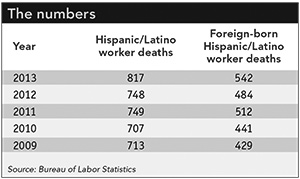La seguridad de los trabajadores latinos
Why are workplace injuries and deaths increasing among Latino employees?

Key points
- Deaths among Latinos/Hispanics are increasing at a time when workplace fatality figures among other demographics are decreasing.
- Culture and language are hugely important to protecting these workers, and employers need to convey safety information in a way and manner their workforce will understand.
- Immigration reform and a stronger OSHA may help reduce Latino worker injuries.
Additional resources
Juan Carlos Reyes was 35 years old when he died.
Reyes was working four stories above ground at a hotel construction site in Texas when his work platform became unstable. He fell to the ground and was later pronounced dead at the scene.
OSHA cited Reyes’ employer for several violations, including failure to ensure the scaffolding was erected by a qualified person and failure to provide a fall arrest system.
Reyes’ story is detailed in an April report from the National Council for Occupational Safety and Health, which claims the father of three might still be alive had he been protected by a fall prevention program that included safety harnesses and proper training.
“It’s not an accident,” the report states. “When employers provide a proper fall protection program, workers can eliminate falls, or reduce the chance of fatal impact if they occur. Reyes had no such chance.”
Fatalities among Latino workers are increasing. And by 2050 about one-third of the U.S. workforce is expected to be Latino – prompting stakeholders to urge for better protections for these workers.
The scope of the problem
In 2013, 4,585 workers died on the job, according to the Bureau of Labor Statistics.
Although this number is the second lowest on record, Latino and Hispanic workers experienced an increase in both the number of on-the-job deaths (817 from 748 in 2012) and fatality rate (3.9 from 3.7) – the only demographic group to do so.
This isn’t a merely a one-year bump in the numbers. Since 2010, the number of Hispanic and Latino worker deaths has steadily increased. And while the rate of death for this population fell in the early 2000s and has remained relatively constant in recent years, that stability stands in contrast to the downward trend among whites, blacks and Asians.
 BLS data on nonfatal incidents shows that Hispanics and Latinos experienced 12 percent of all injuries or illnesses requiring days away from work in 2013 while making up 16 percent of the workforce. However, these figures include only reported injuries.
BLS data on nonfatal incidents shows that Hispanics and Latinos experienced 12 percent of all injuries or illnesses requiring days away from work in 2013 while making up 16 percent of the workforce. However, these figures include only reported injuries.
According to Jessica Martinez, deputy director of National COSH, many Latinos are part of an informal workforce. Martinez said these workers often have no setting for providing documentation or lack safe and consistent employment – part of an “underground” economy in which workers are paid in cash and stay off the books. Injuries suffered by these workers often go uncounted, she said, resulting in low injury figures.
The recession’s role
As the economy recovers, the Latino segment of the workforce has returned to pre-recession employment levels, with particularly strong gains in construction, according to Catherine Singley Harvey. Singley Harvey is manager of the economic policy project at the National Council of La Raza, a Hispanic civil rights and advocacy organization based in Washington.
Employment in industries such as construction or agriculture – some of the most dangerous for workers – is one of the primary contributors to Latino workers’ higher fatality figures. But dangerous jobs don’t tell the whole story. When compared with other ethnicities, Latinos have a higher injury and illness rate within those high-hazard industries. “The Latino workers we know are definitely in a more vulnerable position in comparison to others,” Martinez said.
And Singley Harvey points out that even if the total number of fatalities increased due to growing employment, one would expect the rate to stay the same – yet for Latino workers that hasn’t been the case.
She suggests that the recession could have played another role in increasing injuries: Perhaps employers, in their haste to get projects up and running again, weren’t as diligent in instructing workers on safety and health procedures. She said that when President Barack Obama first took office, his administration was focused on worker safety and health, but the narrative changed to a focus on job growth and job quality. The Department of Labor, which wanted to see the economy moving again, may have let its guard down in terms of enforcing workplace safety requirements, Singley Harvey said.
In addition to dangerous jobs, other systemic issues such as immigration status and language barriers may be driving high injury rates, according to Martinez. She alleged that a few employers may even “shamelessly” violate workers’ rights because the workers fear retaliation.
This can be manifested by inappropriate or ineffective training: The training may not have any intent to instruct workers on safety procedures or policies, but workers will still be told to sign a sheet saying they’ve been properly trained. If they don’t sign, they lose their job, Martinez said.
Some workers are afraid to speak up over unsafe conditions due to their uncertain immigration or job status, or because of a general lack of knowledge regarding their rights, Singley Harvey claims. All of these issues may make workers fearful of being fired – and losing the ability to support their family – so they stay quiet. The result is an increased likelihood of on-the-job injuries.
Post a comment to this article
Safety+Health welcomes comments that promote respectful dialogue. Please stay on topic. Comments that contain personal attacks, profanity or abusive language – or those aggressively promoting products or services – will be removed. We reserve the right to determine which comments violate our comment policy. (Anonymous comments are welcome; merely skip the “name” field in the comment box. An email address is required but will not be included with your comment.)

